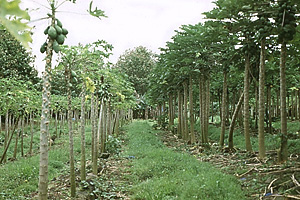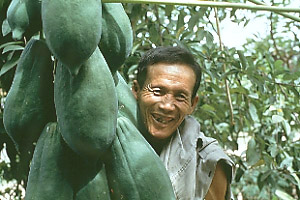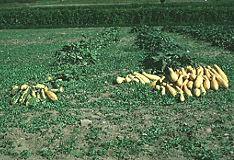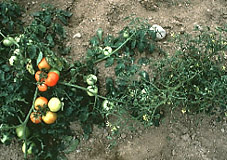Contributed by Baozhong Meng and Augustine Gubba
Meng. B. and Gubba, A. 2000. Genetic Engineering: A novel and powerful tool to combat plant virus diseases. APSnet Features. Online. doi: 10.1094/APSnetFeature-2000-0500B
Plant virus diseases pose severe constraints to the production of a wide range of economically important crops worldwide (Agrios 1997). Diseases caused by plant viruses are difficult to manage and their control mainly involves the use of insecticides to kill insect vectors, the use of virus-free propagating materials, and the selection of plants with appropriate resistance genes. Virus-free stocks are obtained by virus elimination through heat therapy and/or meristem tissue culture, but this approach is ineffective for viral diseases transmitted by vectors. While vectors can be controlled by insecticides, often the virus has already been transmitted to the plant before the insect vector is killed. The use of resistant cultivars has been the most effective means of control, however plant virus resistance genes are frequently unavailable and their introgression into some crops is not straightforward.
Genetic engineering brings new hope for the effective control of plant virus diseases. The concept of pathogen derived resistance (Sanford and Johnston, 1985) has stimulated research on obtaining virus resistance through genetic engineering. Pathogen-derived resistance is mediated either by the protein encoded by the transgene (protein-mediated) or by the transcript produced from the transgene (RNA-mediated). In 1986, Powell-Abel et al. (1986) showed that transgenic tobacco expressing the coat protein gene of tobacco mosaic virus (TMV) was resistant to TMV and that the resistance was due to the expressed coat protein. Recent research indicates that pathogen-derived resistance to viruses is mediated, in most cases, by an RNA-based post-transcriptional gene silencing mechanism. This plant defense system results in degradation of mRNA produced both by the transgene and the virus. In general, protein-mediated resistance provides moderate protection against a broad range of related viruses while RNA-mediated resistance offers high levels of protection only against closely related strains of a virus (Pang et al. 1993, Lomonosoff 1995, Baulcombe 1996a, Dawson 1996).
Coat protein genes have been shown to be effective in preventing or reducing infection and disease caused by homologous and closely related viruses (Gonsalves and Slightom 1993). Coat protein-mediated protection has been reported for tobacco mosaic virus, TMV, (Nelson et al. 1988), tomato mosaic virus, ToMV, (Sanders et al. 1992), cucumber mosaic virus, CMV, (Namba et al. 1991, Quemada et al. 1991), alfalfa mosaic virus, AlMV, (Loeshc-Fries et al. 1987, Tumer et al. 1987), potato virus X, PVX, (Hemenway et al.1988), potato virus Y, PVY, (Perlak et al. 1994), and potato leaf roll virus, PLRV, (Kaniewski et al. 1993). In addition to the coat protein gene, sequences from the viral replicase gene (Palukaitis and Zaitlin 1997), defective virus movement protein genes (Beck et al. 1994, Cooper et al. 1995), satellite virus RNA (Smith et al. 1992), ribozymes (Wilson, 1993) and virus antisense RNA (LeClerc and AbourHaidar, 1995, Yepes et al. 1996) have been engineered into plants to obtain virus resistance. Genetic engineering is proving to be highly effective for controlling virus diseases in a wide range of crops grown worldwide (Wilson, 1993; Gonsalves and Slightom, 1992). Compared to conventional breeding for virus resistance, genetic engineering provides a quicker and more precise technology to obtain plants that are resistant to viruses, although most transgenic virus-resistant plants are still under laboratory development.
|

Figure 2.1 Transgenic papaya plants show resistance (right) while non-transgenic plants (left) are susceptible to papaya ringspot virus under field conditions. Photo courtesy of Dennis Gonsalves, Cornell University.
|
|
|

Figure 2.2 Farmer displaying healthy transgenic papaya fruit in Thailand. Photo courtesy of Dennis Gonsalves, Cornell University.
|
|
One successful example of commercialization is that of transgenic papaya resistant to papaya ringspot potyvirus (PRSV), a virus that causes severe damage to the papaya industry in a number of major producing countries (Lius et al. 1997). In Hawaii, papaya ranks as the second most important fruit crop. Due to the destruction caused by PRSV, papaya production on Oahu island came to a halt in the 1950s. This forced a relocation of the papaya industry in the early 1960s to the Puna district on Hawaii island. Unfortunately, PRSV was discovered in Puna in 1992 and by late 1994 had spread throughout the Puna district (Gonsalves,1998 a and b). Transgenic papaya cultivars Sunrise and Rainbow resistant to PRSV were developed in a collaborative program of Dennis Gonsalves at Cornell University, Richard Manshardt and Maureen Fitch at the University of Hawaii and the USDA, and Jerry Slightom at Upjohn Company. These resistant cultivars were commercialized in Hawaii in 1998. (See APSnet Feature: Transgenic Virus Resistant Papaya). The use of these transgenic papaya cultivars saved the papaya industry in Hawaii from severe damage caused by PRSV Figure 2.1. Through technology transfer, transgenic papaya cultivars that are resistant to various strains of the virus have been developed by Gonsalves’s program to satisfy the need of other papaya producing areas in the world. where different strains of the virus prevail. Transgenic papaya plants are under field trials in Jamaica, Thailand and Brazil (D. Gonsalves, personal communication). The livelihood of farmers in these countries could be impacted positively (Figure 2.2).
Another virus resistant transgenic crop that has been commercially released is transgenic "Freedom II" squash as a result of work by Asgrow Seed Company with collaboration by Gonsalves's program. Freedom II is resistant to zucchini yellow mosaic and watermelon mosaic 2 potyviruses (Fuchs and Gonsalves 1995) Figure 2.3. Transgenic tomato engineered to resist cucumber mosaic virus (CMV), a virus causing severe stunting and yield reductions throughout the world, showed high levels of resistance to CMV under field conditions (Figure 2.4) (Fuchs et al. 1996). Research is underway to generate transgenic tomato plants that are resistant to different strains of tomato spotted wilt virus and different tospoviruses, a group of viruses that seriously limit tomato production in the glasshouse and field, by combining virus transgenes with the native plant resistance gene Sw-5 (Gubba, 2000).
 |
|

|
| Figure 2.3 Transgenic ‘Freedom II’ squash showing resistance to both zucchini yellow mosaic virus and watermelon mosaic virus 2 (right) compared to non-transformed plants that are susceptible (left). The yield differences between the two rows are obvious. The transgenic, protected plants are dark green and their fruits are large and yellow. Photo courtesy of Dennis Gonsalves, Cornell University. |
|
Figure 2.4 Transgenic tomato plants show resistance (left) while non-transformed plants are susceptible to cucumber mosaic virus under field conditions. Note the abundant fruit on the transgenic, protected plant and the absence of fruit on the unprotected plant. Photo courtesy of Dennis Gonsalves, Cornell University. |
Unanswered questions regarding the use of this technology include gene escape from transgenic plants to wild relatives producing "superweeds" and recombination between the invading virus and the transgene leading to the emergence of new viruses with novel host ranges and more potent virulence. It is well documented that gene transfer and virus recombination do occur in nature and they are not restricted to transgenic plants (Trewavas 1999). The question is whether gene transfer and virus recombination will have a negative impact on the environment or agricultural production. Thus, it is necessary to monitor the use of genetic engineering in agriculture. Strategies being formulated to minimize the possibility of gene escape and recombination include the use of short nonfunctional gene fragments or nontranslated versions of virus genes (Jan 1998).
The potential risks of the technology need to be balanced against the proven or potential benefits of biotechnology. Scientists, research institutions, and international organizations should take an active role to promote the wise development of biotechnology. Private corporations and research institutions should make the technology and its products available to developing countries at relatively low or no cost where they are urgently needed (Conway and Toenniessen 1999).
References
Agrios, G. N. 1997. Plant Pathology. Fourth edition. Academic Press, Inc., San Diego, California. 635 pp.
Baulcombe, D. C. 1996a. Mechanisms of pathogen-derived resistance to viruses in transgenic plants. Plant Cell 8: 1833-1844.
Baulcombe, D. C. 1996b. RNA as a target and an initiator of post-transcriptional gene silencing in transgenic plants. Plant Mol. Biol. 32: 79-88.
Beachy, R. N. 1993. Transgenic resistance to plant viruses. Seminars in Virology 4: 327-416.
Beck, D. L., Van Dolleweerd, C. J., Lough, T. J., Balmori, E., Voot, D. M., Anderson, M. T., O’Brien, I. E. W., Forster, R. L. S. 1994. Disruption of virus movement confers broad-spectrum resistance against systemic infection by plant viruses with a triple gene block. Proceedings of the National Academy of Sciences, USA. 91:10310-10314.
Conway, G. and Toenniessen, G. 1999. Feeding the world in the twenty-first century. Nature 402: C55-58.
Cooper, B., Lapidot, M., Heick, J. A., Dodds, J. A. and Beachy, R. N. 1995. A defective movement protein of TMV in transgenic plants confers resistance to multiple viruses whereas the functional analog increases susceptibility. Virology 206: 307-313.
Dawson, W.D. 1996. Gene silencing and virus resistance: A common mechanism. Trends in Plants Science 1:107-108.
Fuchs, M. and Gonsalves, D. 1995. Resistance of transgenic hybrid squash ZW-20 expressing the coat protein genes of zucchini yellow mosaic virus and watermelon mosaic virus 2 to mixed infections by both potyviruses. Bio/Technology 13: 1466-1473.
Fuchs, M, Provvidenti, R., Slightom, J. L., and Gonsalves, D. 1996. Evaluation of transgenic tomato plants expressing the coat protein gene of cucumber mosaic virus WL under field conditions. Plant Disease 80: 270-275.
Gonsalves, D. 1998a. Transgenic virus resistant papaya: new hope for controlling papaya ringspot virus in Hawaii. APSnet Feature article, September 1 through September 30, 1998.
Gonsalves, D. 1998b. Resistance to papaya ringspot virus. Annual Review of Phytopathology 36:415-437.
Gonsalves, D. and Slightom, J. L. 1993. Coat-protein mediated protection: analysis of transgenic plants resistance in a variety of crops. Sem. Virol. 4: 397-406.
Gubba, A. 2000. Transgenic and natural resistance: Towards development of tomato and pepper plants with broad resistance to virus infection. PhD Dissertation, Cornell University, 196 pp.
Hemenway, C., Fang, R-X., Kaniewski, W., Chua, N-H. and Tumer, N. 1988. Analysis of the mechanism of protection in transgenic plants expressing the potato virus X coat protein or its antisense RNA. EMBO J 7: 1273-1280.
Jan, F. J. 1998. Role of nontarget DNA and viral gene length in influencing multiple resistance through homology-dependent gene silencing. PhD Dissertation, Cornell University, 1998.
Kaniewski, W., Lawson, C. and Thomas, P. 1993. Agronomically useful resistance in Russet Burbank potato containing a PLRV CP gene. Abstract. IX International Congress of Virology, Glasgow, Scotland.
LeClerc, D. and Abou Haidar, M. G. 1995. Transgenic tobacco plants expressing a truncated form of the PAMV capsid protein (CP) gene show CP-mediated resistance to potato aucuba mosaic virus. Mol Plant-Microbe Interact 8: 58-65.
Lius, S., Manshardt, R. M., Fitch, M. M. M., Slightom, J. L., Sanford, J. C. and Gonsalves, D. 1997. Pathogen-derived resistance provides papaya with effective protection against papaya ringspot virus. Mol. Breed. 3: 161-168.
Loesch-Fries, L. S., Merlo, D., Sinnen, T., Burhop, L., Hill, K., Krahn, K., Jarvis, N., Nelson, S. and Halk, E. 1987. Expression of alfalfa mosaic virus RNA 4 in transgenic plants confers virus resistance. EMBO J 6: 1845-1852.
Lomonossoff, G. P. 1995. Pathogen-derived resistance to plant viruses. Annual Review of Phytopathology 33: 323-343.
Namba, S., Ling, K., Gonsalves, C., Gonslaves, D. and Slightom, J. L. 1991. Expression of the gene encoding the coat protein of cucumber mosaic virus (CMV) strain WL appears to provide protection to tobacco plants against infection by several different CMV strains. Gene 107: 181-188.
Nelson, R. S., McCormick, S. M., Delanney, X., Dube, P., Layton, J., Anderson, E. J., Kaniewska, M., Prosksch, R. K., Horsch, R. B., Rogers, S. G., Fraley, R. T. and Beachy, R. N. 1988. Virus tolerance, plant growth, and field performance of transgenic tomato plants expressing coat protein from tobacco mosaic virus. Bio/Technology 6: 403-409.
Palukaitis, P. and Zaitlin, M. 1997. Replicase-mediated resistance to plant virus disease. Advances in Virus Research 48: 349-377.
Pang, S-Z., Slightom, J. L., and Gonsalves, D. 1993. Different mechanisms protect transgenic tobacco against tomato spotted wilt and Impatiens necrotic spot tospoviruses. Bio/Technology 11: 819-824.
Perlak, F., Kaniewski, W., Lawson, C., Vincent, M. and Feldman, J. 1994. Genetically improved potatoes: Their potential role in integrated pest management. In: M. Manka (ed). Proceed. 3rd EFPP Conference. J Phytopath pp 451-454.
Powell-Abel, P., Nelson, R. S., De, B., Hoffmann, N., Rogers, S. G., Fraley, R. T. and Beachy, R. N. 1986. Delay of disease development in transgenic plants that express the tobacco mosaic virus coat protein gene. Science 232: 738-743.
Quemada, H. D., Gonsalves, D. and Slightom, J. L. 1991. Expression of coat protein gene from cucumber mosaic virus strain C in tobacco: Protection against infections by CMV strains transmitted mechanically or by aphids. Phytopathology 81: 794-802.
Sanders, P. R., Sammons, B., Kaniewski, W., Haley, L., Layton, J., Lavallee, B. J., Delannay, X. and Tumer, N. E. 1992. Field resistance of transgenic tomatoes expressing the tobacco mosaic virus or tomato mosaic virus coat protein genes. Phytopathology 82: 683-690.
Sanford, J. C and Johnston, S. A. 1985. The concept of parasite-derived resistance–deriving reistance genes from the parasite's own genome. J. Theor. Biol. 113: 395-405.
Smith, C. R., Tousignant, M. E., Geletka, L. M. and Kaper, J. M. 1992. Competition between cucumber mosaic virus satellite RNAs in tomato seedlings and protoplasts: A model for satellite-mediated control of tomato necrosis. Plant Disease 76:1270-1274.
Tumer, N. E., Hemenway, C., O ‘Connell, K., Cuozzo, M., Fang, R-X, Kaniewski, W. and Chua, N-H. 1987. Expression of coat protein genes in transgenic plants confers protection against alfalfa mosaic virus, cucumber mosaic virus and potato virus X. Pages 351-356 In: Plant Molecular Biology. D. von Wettstein and N-H. Chua (eds). Plenum Publishing Corporation.
Trewavas A. 1999. Gene flow and GM questions. Trends in Plant Science, 4: 339.
Wilson, T. M. A. 1993. Strategies to protect crop plants against viruses: pathogen-derived resistance blossoms. Proceedings of National Academy of Sciences (USA) 90: 3134-3141.
Yepes, L. M., Fusch, M., Slightom, J. L. and Gonsalves, D. 1996. Sense and antisense coat protein gene constructs confer high levels of resistance to tomato ringspot nepovirus in transgenic Nicotiana species. Phytopathology 86: 417-424
RETURN TO APSnet FEATURE STORY